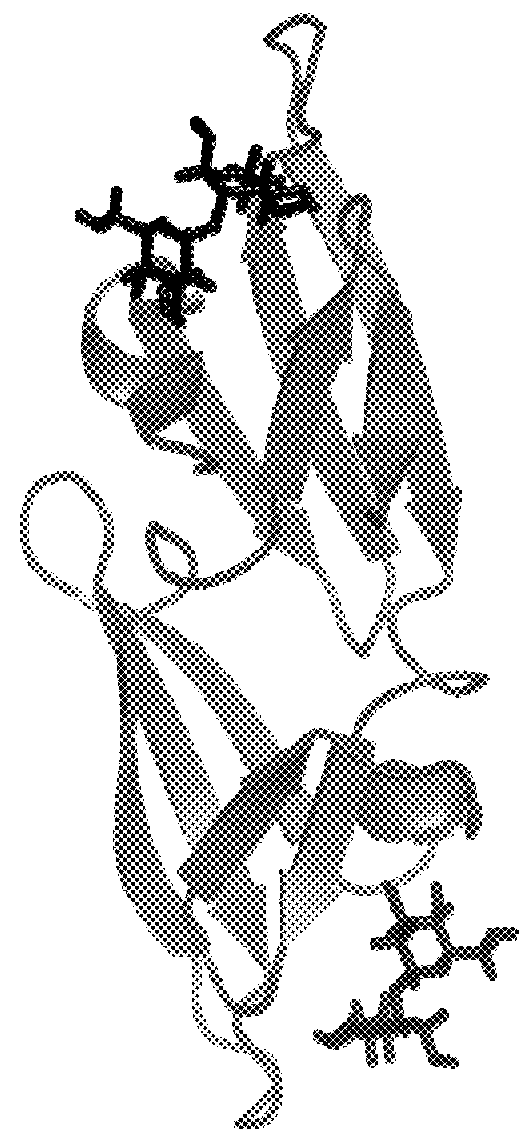Engineered lectin oligomers with antiviral activity
a technology of lectin and oligomer, which is applied in the field of engineered lectins, can solve the problems of no vaccine for ebola virus, high lethal contagious virus, and significant limitations of current vaccines, and achieves the effects of improving the neutralization effect of influenza strain x31, improving the effect of influenza neutralization, and improving the effect of antiviral activity
- Summary
- Abstract
- Description
- Claims
- Application Information
AI Technical Summary
Benefits of technology
Problems solved by technology
Method used
Image
Examples
exemplary embodiment 1
Lectin Oligomerization Applied to HIV Neutralization
[0078]In a first embodiment of the invention, engineered lectins are described that have dramatically enhanced neutralization for targeted enveloped viruses. In particular, it has been surprisingly discovered that linked oligomerization of lectins results in a more than 10-fold enhancement of the intrinsic neutralization capability of CVN through engineered linked dimerization. Accordingly, in a first embodiment a lectin, such as, for example, CVN is oligomerized to enhance the interaction of the protein against specific glycosylation sites on the protein envelope of viruses.
[0079]Treatment and prevention of HIV-1 have proven to be difficult and complex problems. Vaccines thus far have been unsuccessful in generating broadly reactive neutralizing antibodies that confer immunity to the virus, partly because of HIV-1's rapid mutation rate and partly because of the lack of epitopes on its envelope proteins. The HIV-1 envelope is compo...
exemplary embodiment 2
Lectin Oligomerization on Other Viral Neutralization
[0140]Although CVN has long demonstrated significant utility at preventing HIV infections, it is only moderately active against the following enveloped viruses: influenza, Ebola (Ebo-Z), herpes simplex virus-1, Eppstein-Barr virus, human herpes virus-6, and BVDV (a surrogate for hepatitis C). (See, Barrientos, L. G., et al., Structure, 12:1799-1807, 2004; Barrientos, L. G., et al., Antiviral Res, 58:47-56, 2003; and O'Keefe, B. R., et al., Antimicrobial Agents &Chemo, 47(8):2518-2525, 2003, the disclosures of each of which are incorporated herein by reference.)
[0141]The glycoprotein GP1,2 present on the surface of Ebola virus particles displays oligosaccharides that are similar to those found on HIV's gp120; however, CVN's EC50 for HIV is 0.1 to 5 nM (depending on the strain), while its EC50 for Ebola (Ebo-Z) is 100 nM (i.e., it is 20 to 1,000-fold less effective against Ebola than it is against HIV). (See, e.g., Barrientos, L. G. ...
exemplary embodiment 3
Lectin Oligomerization Structural Studies
[0151]As previously discussed, CVN exists in solution both as a monomer and a domain-swapped dimer, as shown in FIG. 1. The monomer consists of two pseudo-domains that display high sequence homology. The first domain contains residues 1-39 and 90-101, and the second domain contains residues 39-89. (See, Bewley, C. A., et al., Nat Struct Biol, 5, 571-8, 1998, the disclosure of which is incorporated herein by reference.) CVN includes a three-stranded antiparallel β sheet and a β hairpin in each pseudo-domain. The pseudo-domains are connected through two helical turns. CVN also contains two native disulfide bridges: between residues 8 and 22, and between residues 58 and 73. These two disulfide bridges are located near each end of the molecule and anchor the first strand of the β sheet to the second strand. The dimer contains the same topology, but is domain-swapped at residues 51-53. (See, Yang, F., et al., J Mol Biol, 288, 403-12, 1999, the dis...
PUM
| Property | Measurement | Unit |
|---|---|---|
| Ka | aaaaa | aaaaa |
| pH | aaaaa | aaaaa |
| flow rate | aaaaa | aaaaa |
Abstract
Description
Claims
Application Information
 Login to View More
Login to View More - R&D
- Intellectual Property
- Life Sciences
- Materials
- Tech Scout
- Unparalleled Data Quality
- Higher Quality Content
- 60% Fewer Hallucinations
Browse by: Latest US Patents, China's latest patents, Technical Efficacy Thesaurus, Application Domain, Technology Topic, Popular Technical Reports.
© 2025 PatSnap. All rights reserved.Legal|Privacy policy|Modern Slavery Act Transparency Statement|Sitemap|About US| Contact US: help@patsnap.com



